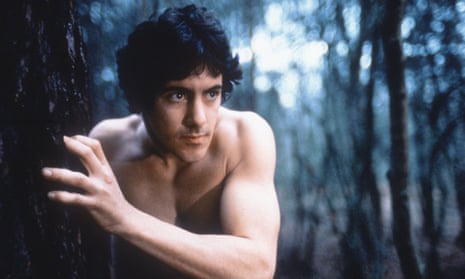Forty years on from its release, An American Werewolf in London is not a film best remembered for its subtlety. John Landis’s then-unique, much-imitated horror-comedy hybrid built a cult following on its gnarly makeup effects, goofy sense of humour and discordant soundtrack of perky, on-the-nose pop songs – if it had “moon” in the title, it was good to go – but these are broad, brash virtues: a cheeky adolescent sensibility realised with all the toys in the playroom. Roger Ebert, for one, was not a fan: “Landis spent all his energy on spectacular set pieces,” he grumbled, “and then didn’t want to bother with things like transitions, character development, or an ending.”
He was sort of right and sort of wrong. Revisited today, An American Werewolf in London is indeed a strange, brisk, moody beast, its plotting lean and sudden, its tone turning on a dime from jokey genre shenanigans to genuine, violent terror. Audiences weren’t so much baited and switched as they were baited, assaulted and nudged in the ribs, repeatedly, and in varying order. But that jagged, irreverent volatility is a large part of the film’s spell: it’s a story of fast, unexpected transition that keeps us interested – and disoriented – with fast, unexpected transitions of its own. Fitting that I remembered seeing it, surrounded by fellow shrieking, too-young schoolmates, back in a childhood VHS era as it is, perhaps, the ideal film to see too young, when its gore is still verboten enough to exhilarate and shock, while its cartoonish, ketchup-stained quality raises exactly the right kind of giggle.
The great surprise to me on a recent rewatch, however, was indeed its unlikely restraint: its grisly excesses may make all the clip reels these days, but Landis’s film is ultimately a taut, teasing exercise in delayed gratification, followed by oddly economical carnage. I had forgotten, for example, that its viscerally realised, now-iconic scene of genial, clean-cut American backpacker David Kessler (David Naughton) turning, body part by body part, into a fanged, furred creature of the night – a dazzling practical-effects showreel that inarguably won the prosthetics maestro Rick Baker the inaugural Oscar for best makeup – only occurs a full hour into a film that runs a little over 90 minutes.
Give or take the hasty, quick-cut werewolf attack that infects David in the first place, that amounts to a film of two-thirds foreplay and one-third sputtering, deranged action. It’s not as if the story has any particular place to go after our hero finds his inner wolf; the transformation is the money shot, so why give it away too soon, or dawdle too long after? It’s fitting that the film’s climax – so to speak – begins in a seamy London porn cinema, given that Landis has, in some respects, structured his film much like the archetypical porno in terms of build and release. (Put that way, perhaps pre-teens were too young for it after all.) It’s hard to imagine most contemporary studio horror blockbusters making their audience wait that patiently for such a key reveal and bloody payoff. At a budget of under $6m, An American Werewolf in London may not have been made as a blockbuster; with a global gross of $62m, however, it was a success that proved the value of a long game, however juvenile.
The comedy component, too, is slyer and drier than I recalled. As a child in South Africa, its barbs at the expense of Margaret Thatcher’s insular, exclusory, conservative Britain went over my head; today, if you squint at it the right way, there’s a faint blueprint for Brexit Island in its depiction of the country’s passive aggression toward tourists, its rigid deferral to authority and its hostile barriers of class. (I laughed, perhaps most heartily of all, at the priggish City businessman, frightened and alone at Tottenham Court Road station, whose response to an unseen werewolf’s echoing growls in the tunnels is a firm, entitled “we are not amused” admonishment and a threat to call the police.)
Did Landis, a crass, young Yank on a British co-production, intend to capture his hosting country that pointedly? Or does the outsider’s eye simply capture more truth than it even intends? Either way, the film remains the creative peak of his career – call it full-moon film-making if you will – two years before those legacy-derailing charges of involuntary manslaughter relating to the deaths of three people on the set of 1983’s Twilight Zone: The Movie. Hollywood being the club it is, his work rate may have recovered, but his work never really did. Argue for the slicker comic beats of Coming to America or the sleeker spectacle of the Thriller video if you will – driven, respectively, by the extraordinary motors of Eddie Murphy and Michael Jackson as much as they are by their director – but he never regained An American Werewolf in London’s wild sense of danger, strangeness or patience.

Comments (…)
Sign in or create your Guardian account to join the discussion